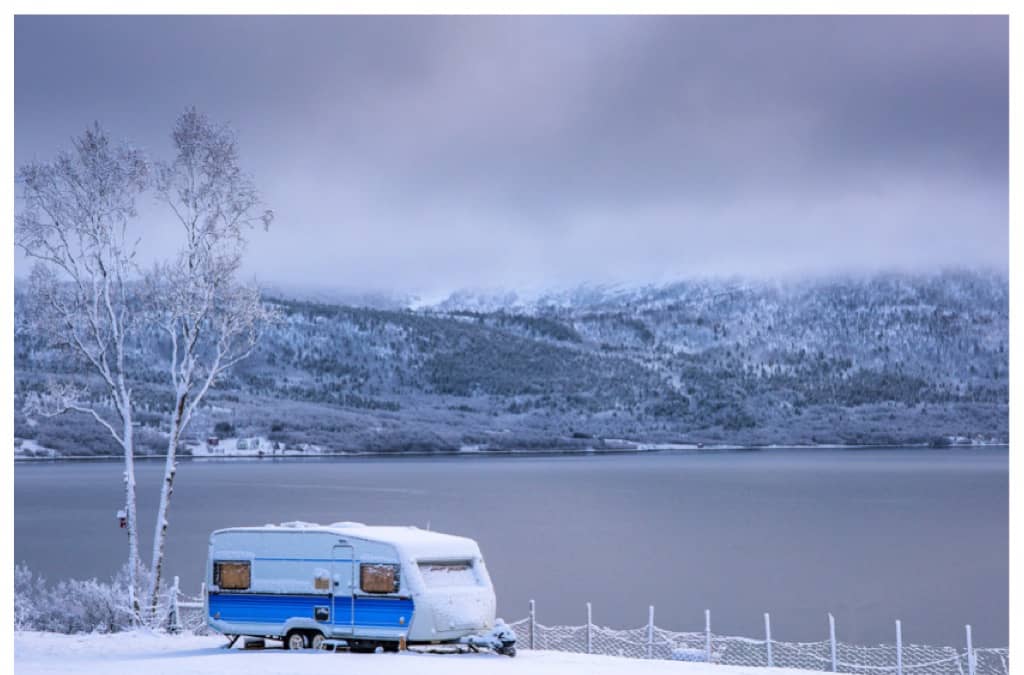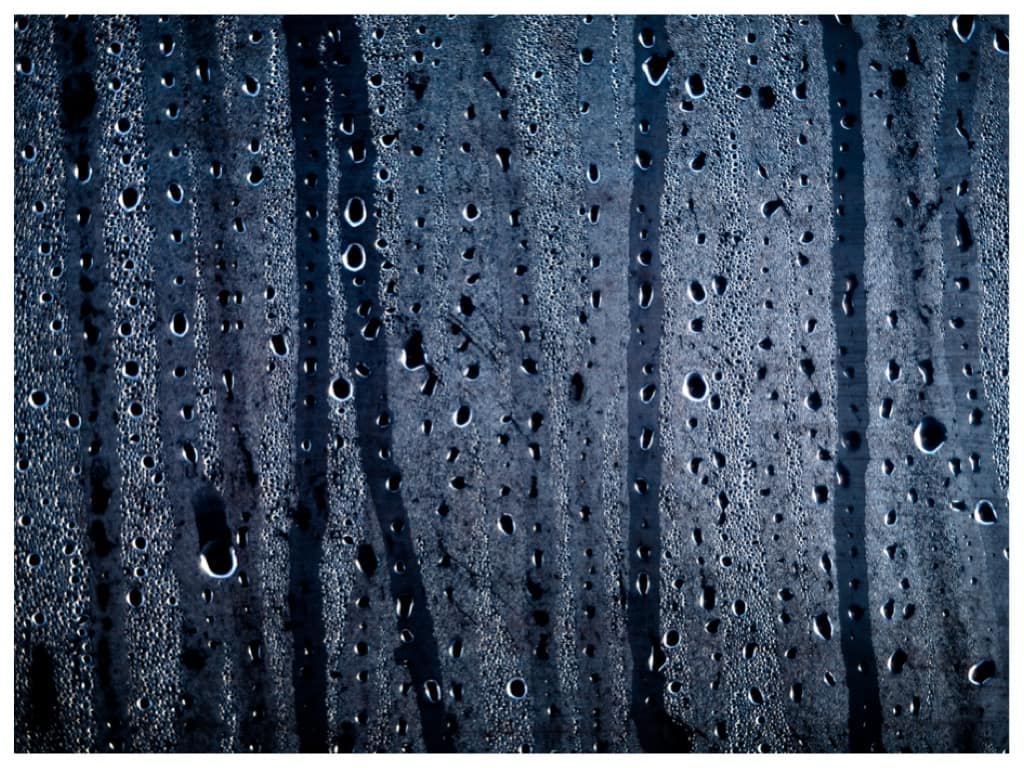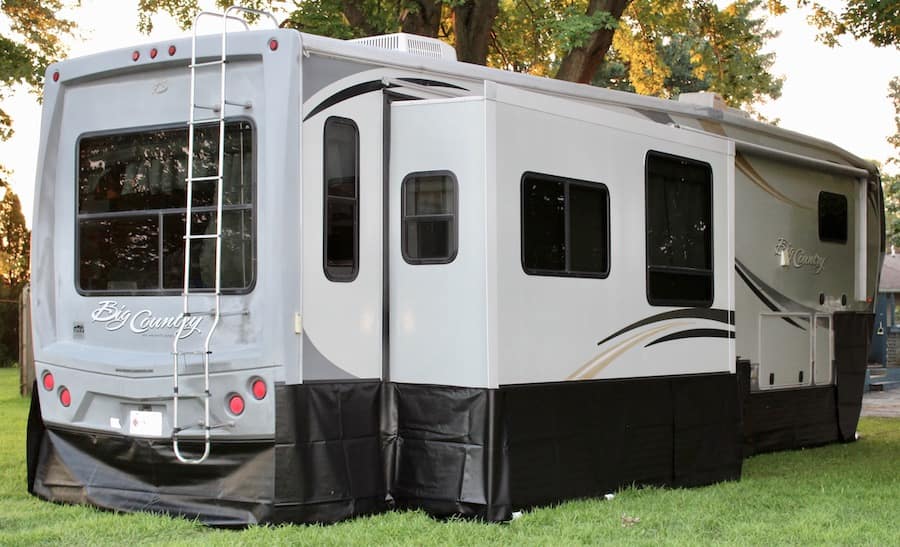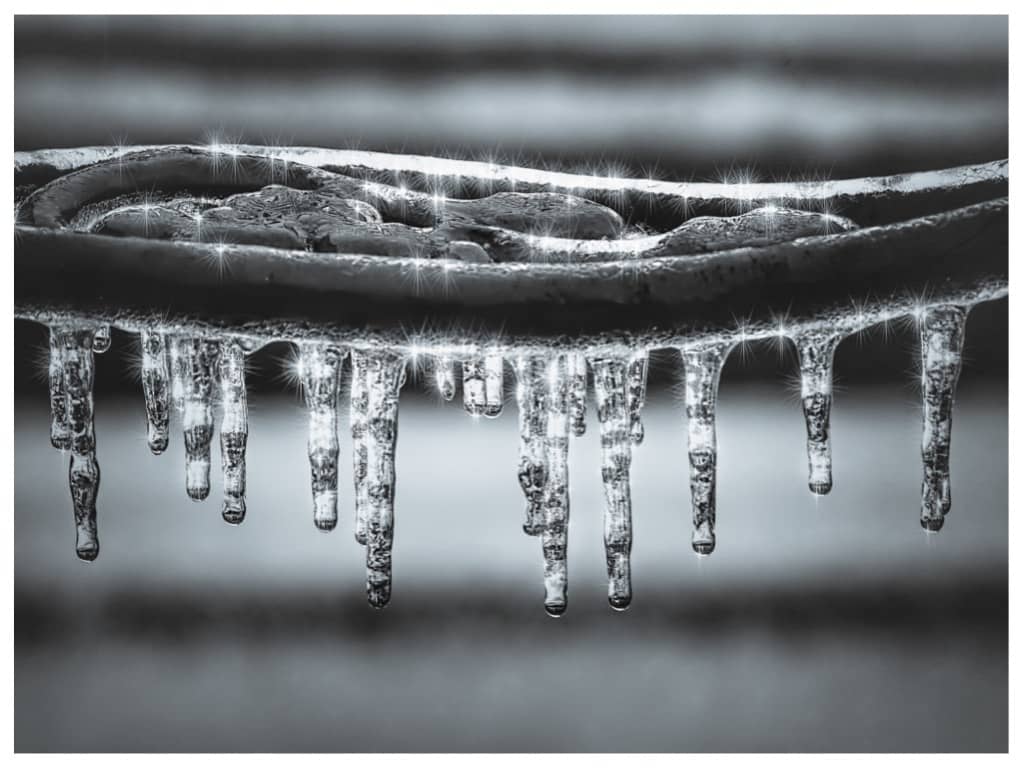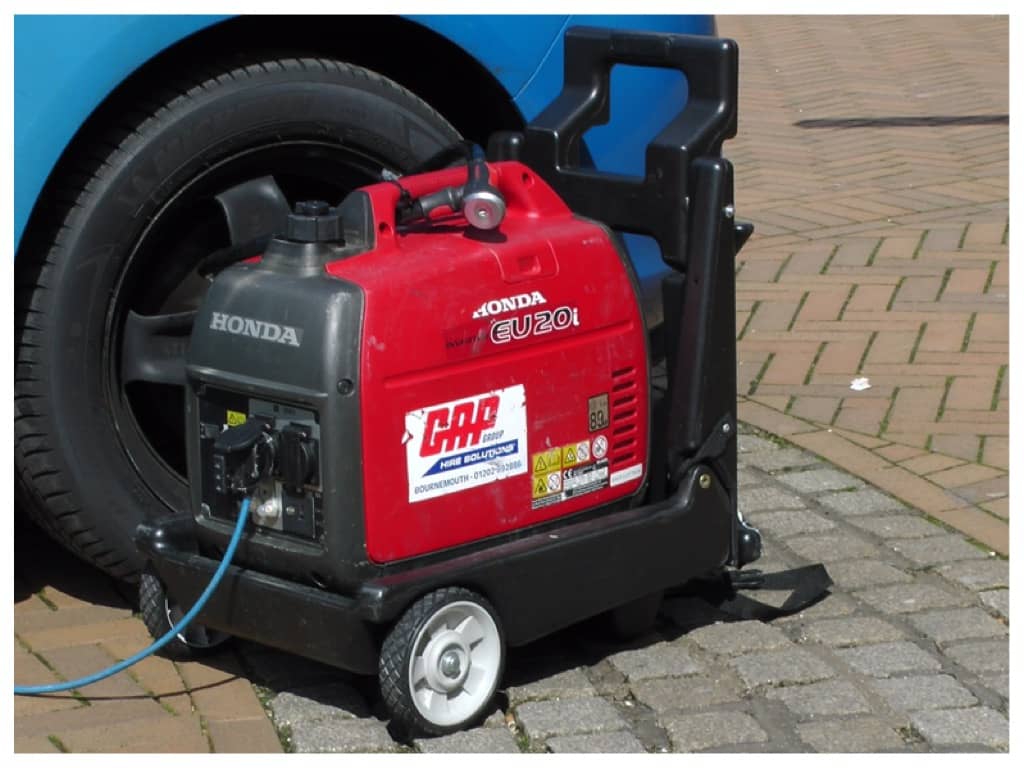This article may contain compensated links, please read our disclaimer for more information.
The cold weather has officially arrived. For most part-time campers this means packing up the RV and putting it in storage. Full timers, on the other hand, have to find ways to continue RVing in cold weather safely, comfortably, and without damaging their tiny homes.
Some may say this simply isn’t possible. However, it’s been proven time and time again that it is completely possible to live out the winter in a motorhome or travel trailer. All it takes is a bit of extra work on your part and you’ll maintain a perfectly functional home while also remaining cozy and warm all winter long.
Not sure where to begin preparing for winter in your RV? Here are our top tops for winter RVing.
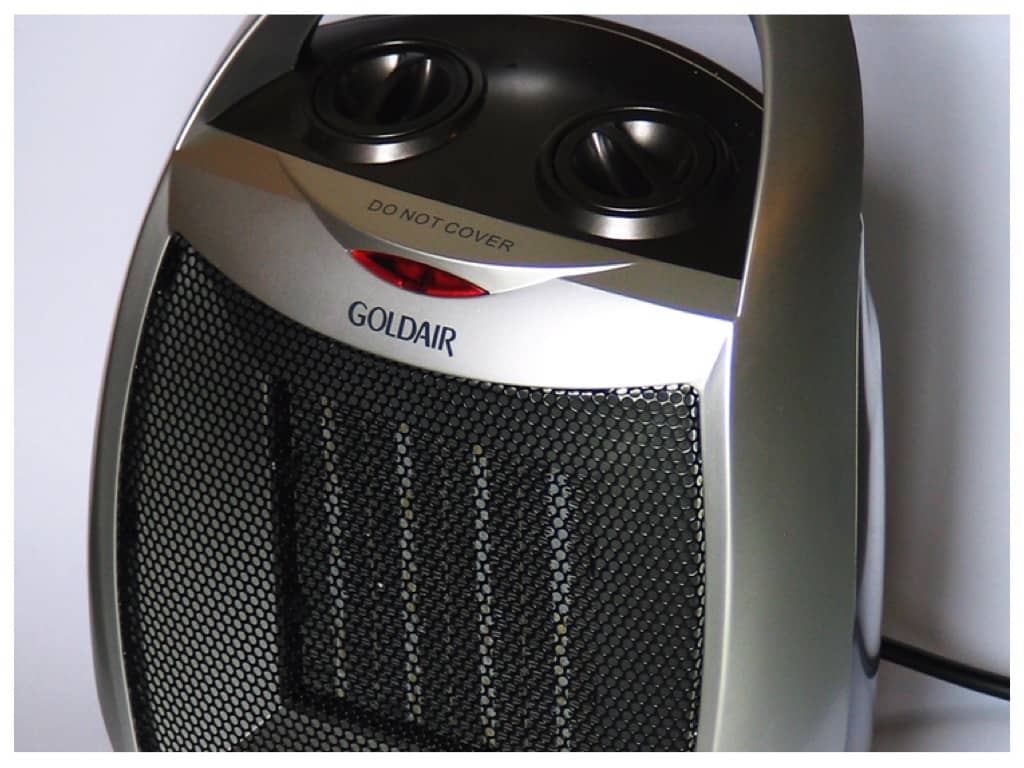
Image source: Benchill
Choose the Right Heat Source
Obviously, you will need to keep the rig warm while RVing in cold weather. Most people would assume the RV furnace would be the best tool for this job. Unfortunately, this just isn’t true. RV furnaces tend to be very inefficient and they can very quickly eat through an entire tank of propane.
Fortunately, there are other options.
For Campground Camping
If you’ll be in a campground, and especially if the electricity is included in your camping fees, electric heat is almost always the best choice. Pick up some small, ceramic space heaters that shut off when tipped, plug them in, turn them on, and you’ll be good to go. This will keep you warm while also saving you money.
For Boondocking
Those who will be camping without hookups will need to find options that don’t involve electricity. In this case, propane heaters are the best bet, but we still don’t recommend the RV furnace. Instead, we tend to turn to the Mr. Buddy portable propane heater.
You will want to crack a window while your Mr. Buddy heater is in use, but you’ll get plenty of heat, use less propane, and stay warm without using any of your RV battery power.
Reduce Condensation
Now that you know how to keep warm, the next issue you’ll need to address when RVing in cold weather is condensation.
When staying in an RV in cold weather, you’ll find that condensation is plentiful. It accumulates on the windows and sometimes even the walls. This is not only annoying, it can also damage the rig by causing mold to grow, or even rotting wood.
Here’s how to avoid these issues.
Avoid Creating Moisture
While you won’t be able to avoid creating condensation entirely, it certainly does help to cut back on the amount of moisture you put into the air. If possible, avoid cooking things that create a lot of steam, or take your cooking outdoors. Keep showers short and sweet, and don’t run propane heaters unless absolutely necessary.
Let Moisture Escape
It also helps to let the moisture in the RV escape. You can do this by venting the stove while cooking, turning on a vent fan while showering, and venting your propane heater to the outdoors. This sends the water outside, helping cut back on the condensation that gathers in your RV.
Invest in a Dehumidifier
A dehumidifier will help pull the remaining moisture out of the air, allowing you to dump the water outside rather than watch it accumulate on the walls and windows. Be sure you get a good-sized unit, and make sure you empty it often enough.
Use DampRid
Finally, we highly recommend using DampRid in cabinets and drawers that tend to gather a lot of moisture. Thi product absorbs the water in the air so it can’t stick to surfaces and subsequently ruin walls, cabinets, and/or other items.
Add Extra Insulation
It’s no secret that RVs aren’t exactly the most well-insulated living spaces on earth. For this reason, many full-time RVers choose to add extra insulation here and there when RVing in cold weather. There are a few different ways to go about this.
RV Skirting
If you’re stationary or don’t move often, you might consider some sort of RV skirting. Skirting goes around the bottom of your motorhome or trailer to keep wind out and insulate the underside of the rig.
It can be a heavy cloth that you hang, foam board, sand bags, vinyl, or any other material that you can find to build up around your home-on-wheels.
Insulate Windows
Windows let in a lot of cold. For this reason, you might want to consider adding a bit of insulation to your home by covering the windows. Reflectix works nicely for this, but even something as simple as a towel hung across a window can be helpful.
Cover Skylights, Vents, and Cracks
Skylights and vents also let in cold air, and the winter weather loves to sneak into cracks around slides and doors. Try adding covers to your roof vents and skylights, and put towels over spots where cold breezes might slip in.
Avoid Frozen Water
Another thing to think about when RVing in cold weather is your plumbing system. RV water lines can and will freeze. On top of that, holding tanks can become frozen solid, as can the freshwater and sewer hoses.
Nobody wants to deal with a frozen water system, especially if that freeze leads to a broken tank or line. Therefore, it’s best to avoid this altogether by taking some preventative steps.
RV Antifreeze
Always keep RV antifreeze on hand. If the weather is going to fall well below freezing for a very long period of time, winterize your water lines by pumping the antifreeze through them and then adding some antifreeze to your tanks.
If the temperatures will only dip a bit below freezing for a couple of hours at night, simply pour some of the antifreeze into your black and gray tanks to keep them from freezing.
Keep Tanks Closed
Speaking of your black and gray tanks, go ahead and keep those closed during freezing temperatures. The antifreeze will keep them from freezing up, but a tank left trickling can’t hold the antifreeze.
Keep Lines Warm
It’s also a good idea to keep your water lines and pipes warm anytime they aren’t winterized. Heat lights or small space heaters can be placed under the RV to keep exposed plumbing nice and toasty, and cabinets can be kept open to let warm air under them where the water runs.
It should also be noted that this is one time we do suggest running the furnace—namely, if you have a heated underbelly and the temperatures will be falling below freezing for a while. In this case, the furnace will keep things from freezing up.
Heated Water Hose
The freshwater hose running from the spigot to the side of your rig will not be protected by your heat lamps or space heaters. Therefore, it’s ideal to pick up a heated water hose to keep the water flowing.
Insulated Sewer Hose
Obviously, you will still need to dump your tanks now and then, even when the weather is freezing. For this reason, it’s not a bad idea to insulate your sewer hose to keep it from freezing up. After all, nobody wants to deal with a poopsicle.
Be Prepared for Emergencies
No matter where you live, it’s always best to be prepared for emergencies. That said, this is even more important when living in an RV, especially if you camp far from a town and other people.
Try these ideas to ensure you’re prepared for any winter emergencies that come your way.
Have a Generator and Fuel
A generator is the perfect thing to have on hand in case you lose power. This will allow you to keep your RV battery charged. As long as your battery is charged, you can use lights, the refrigerator, and your furnace. Of course, you will need fuel to run the generator, so make sure you have some of that on hand as well.
Fill Propane Tanks
A full battery is important for running the RV furnace and fridge without power. That said, these aren’t the only things you’ll need. You’ll also need to make sure you have propane available. Propane is also used for running your RV stove and oven. For this reason, keeping your propane tanks full is incredibly important when winter RVing.
Stock Up on Blankets and Food
Plenty of blankets and layers of clothing will help keep you warm in case the furnace can’t keep up. Be sure you have extras available to you.
Food is also important to have plenty of in case you end up snowed in. We recommend stocking your pantry with non-perishable, nutritious foods to have, just in case.
Keep a Phone Charged
Lastly, you will want to make sure your phone always has a charge. We also recommend camping in an area with cell reception. Doing these things will allow you to call for help should something go terribly wrong.
Consider a Warm Location
Do all of these extra steps feel a bit overwhelming? You do have another option, and no, we don’t mean moving into a traditional home.
Many full-time RVers choose to simply head south for the winter in order to avoid freezing temperatures and enjoy sunshine all year long. After all, if your home has wheels, you might as well take advantage of that fact, right?
Some favorite wintertime RVing locations include:
- Florida
- Southern California
- Texas
- Arizona
- Mexico
Pick one of these places and you won’t need to worry as much about frozen water lines, condensation, types of heaters, and winter emergency preparedness.
Join Fulltime Families
Fulltime Families Members get access to the best resources, community and discounts.
Fulltime Families is a participant in the Amazon Services LLC Associates Program, an affiliate advertising program designed to provide a means for sites to earn advertising fees by advertising and linking to amazon.com, amazon.co.uk, amazon.ca. Amazon and the Amazon logo are trademarks of Amazon.com, Inc. or its affiliates.

